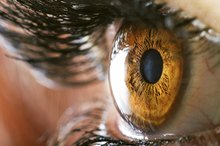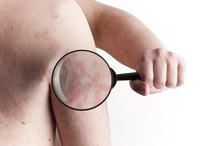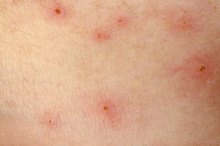What does fact checked mean?
At Healthfully, we strive to deliver objective content that is accurate and up-to-date. Our team periodically reviews articles in order to ensure content quality. The sources cited below consist of evidence from peer-reviewed journals, prominent medical organizations, academic associations, and government data.
The information contained on this site is for informational purposes only, and should not be used as a substitute for the advice of a professional health care provider. Please check with the appropriate physician regarding health questions and concerns. Although we strive to deliver accurate and up-to-date information, no guarantee to that effect is made.
Cholesterol and Pimples
Acne affects about 85 percent of teens and 20 percent of adults in the United States, according to the Acne Resource Center. Pimples form when bacteria, oil and dirt block pores, causing inflammation. Hormones, which trigger the production of sebum, also play a role in their formation. There is no link between cholesterol and acne breakouts 1. Cholesterol deposits, however, also known as xanthomas, are small lesions that resemble pimples.
Cholesterol Deposits
Xanthomas are small fat deposits that can break out on any area of the body, but are most often seen beneath the surface of the skin on knees, feet, elbows, joints, tendons, hands and buttocks. Xanthomas are a common skin condition and occur most frequently in seniors and individuals with high blood lipids, or fats, according to the University of Maryland Medical Center. Cholesterol deposits look like yellow sores or bumps and are soft to the touch, similar to whiteheads, papules or pustules. Lesions usually resolve on their own after several weeks.
- Xanthomas are small fat deposits that can break out on any area of the body, but are most often seen beneath the surface of the skin on knees, feet, elbows, joints, tendons, hands and buttocks.
Treatment
High Cholesterol Effects on Eyes
Learn More
Cholesterol deposits are often indicative of an underlying health condition, according to New York University’s Langone Medical Center. Treating the underlying condition -- often a metabolic disorder like diabetes -- can prevent the fatty deposits from developing. Other treatment options include removal via surgery, laser or trichloroacetic acid. Keeping blood lipid and cholesterol levels in check can help prevent an outbreak. If you apply salicylic acid or benzoyl peroxide to the spots and they clear, your outbreak was, more likely than not, caused by acne.
- Cholesterol deposits are often indicative of an underlying health condition, according to New York University’s Langone Medical Center.
- Treating the underlying condition -- often a metabolic disorder like diabetes -- can prevent the fatty deposits from developing.
Lower Cholesterol
An eruption of pimple-like lesions on the skin could be the least of your problems if you have high cholesterol. Too much cholesterol in the blood can lead to heart disease, according to the American Heart Association 3. Lifestyle changes that help to lower blood lipids include eating a healthy, low-fat diet, exercising regularly and avoiding cigarettes. If cholesterol levels are beyond the control of lifestyle changes, prescription medications help lower blood fats. Statins are medications that prevent the formation of cholesterol and are most effective at decreasing LDL, or “bad” cholesterol. Selective cholesterol absorption inhibitors prevent the absorption of blood lipids from the intestines.
- An eruption of pimple-like lesions on the skin could be the least of your problems if you have high cholesterol.
- Too much cholesterol in the blood can lead to heart disease, according to the American Heart Association 3.
Other Information
What Is the Difference Between Stasis Dermatitis & Cellulitis?
Learn More
While cholesterol deposits are not dangerous, they could be a sign of a serious condition, such as certain cancers or inflammation of bile ducts in the liver. Xanthomas that develop on the eyelids, known as xanthelasma palpebra, are less likely to have an underlying medical cause and may not even be indicative of elevated cholesterol levels. If an outbreak occurs, your doctor should test your blood and liver function. You should also rule out diabetes, especially if you’re overweight, frequently feel parched and fatigued, and urinate often. About 33 percent of diabetes patients have skin problems, reports the American Diabetes Association; it’s often the first sign of the metabolic disorder 4.
- While cholesterol deposits are not dangerous, they could be a sign of a serious condition, such as certain cancers or inflammation of bile ducts in the liver.
Related Articles
References
- Acne.org: What is Acne?
- NYU Langone Medical Center; Xanthelasma and Xanthoma; September 2010
- American Heart Association; Prevention and Treatment of High Cholesterol; June 2011
- American Diabetes Association: Skin Complications
- Centers for Disease Control and Prevention. Heart disease facts. Updated November 28, 2017.
- Harada-Shiba M, Arai H, Ishigaki Y, et al. Guidelines for diagnosis and treatment of familial hypercholesterolemia 2017. J Atheroscler Thromb. 2018;25(8):751-70. doi:10.5551/jat.CR003
- American Heart Association. Heart-health screenings. Updated March 22, 2019.
Writer Bio
Shannon Marks started her journalism career in 1994. She was a reporter at the "Beachcomber" in Rehoboth Beach, Del., and contributed to "Philadelphia Weekly." Marks also served as a research editor, reporter and contributing writer at lifestyle, travel and entertainment magazines in New York City. She holds a Bachelor of Arts in literature from Temple University.








